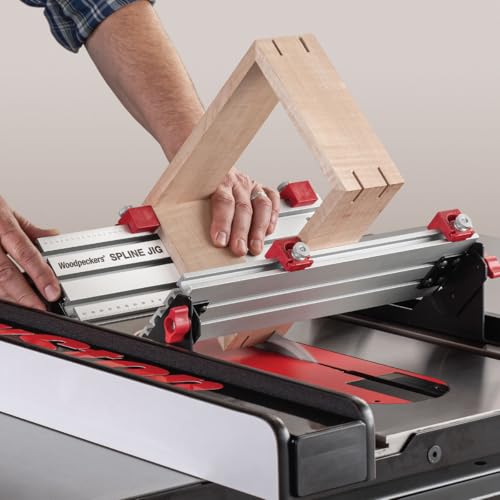If you’ve ever struggled with creating perfect dovetail joints, you’ll know the frustration of misaligned cuts and wasted material. A quality dovetail jig for your router table can transform this challenging task into a precise, repeatable process. Whether you’re crafting drawers, boxes, or fine furniture pieces, selecting the right jig will determine your project’s success. Let’s explore four top-rated options that’ll help you achieve professional-grade results.
Dovetail Jig Kit for Woodworking (11″ Wide)
The Rockler Dovetail Jig Kit delivers professional-grade joinery in a compact 11″ design that’s ideal for woodworkers who need precision without breaking the bank. You’ll get versatile templates that cut half-blind dovetails from 1/2″ to 1-1/8″ thick and through dovetails from 3/8″ to 3/4″ thick.
The kit includes three carbide-tipped router bits, a collet adapter, and a guide bushing that fits Porter Cable routers. While initial setup requires patience, the exclusive one-piece stop guarantees accurate offset. You can mount it permanently to your bench or create a movable base using the two pre-drilled holes.
Best For: Intermediate to advanced woodworkers seeking a reliable, mid-range dovetail jig for creating professional-looking joints in smaller furniture and cabinet projects.
Pros:
- Complete kit includes all necessary components (router bits, templates, guide bushing)
- Versatile capacity handles both half-blind and through dovetails in various stock thicknesses
- Exclusive one-piece stop ensures consistent accuracy in joint alignment
Cons:
- Instructions lack clarity and may be difficult to follow
- Initial setup process is time-consuming and requires multiple adjustments
- 8mm collet reducer prone to sticking in non-Rockler routers
VEVOR Dovetail Jig 12-inch with Router Bit & Template
Designed for woodworkers seeking an entry-level dovetail solution, VEVOR’s 12-inch jig offers essential features for crafting small furniture and drawers. The aluminum alloy construction with electrostatic spray finish resists corrosion and deformation while handling wood up to 1.57 inches thick.
You’ll get two 1/2-inch router bits and a half-blind template that processes widths from 5.5-12 inches on top and 5.9-11 inches on the side. The eccentric wheel design helps secure your workpiece, but be prepared for a learning curve – the unclear instructions and mixed quality reviews suggest you might need patience to master this budget-friendly option.
Best For: Budget-conscious hobbyist woodworkers and DIY enthusiasts looking for a basic dovetail jig to create simple drawer joints and small furniture pieces.
Pros:
- Durable aluminum alloy construction with corrosion-resistant finish
- Versatile processing width range accommodates various project sizes
- Includes two router bits and secure clamping mechanism with eccentric wheel design
Cons:
- Poor instruction manual makes assembly and setup challenging
- Inconsistent quality control reported by customers
- May require significant practice and adjustment to achieve precise joints
Woodpeckers Spline Jig for Router Table & Table Saw
Precision-engineered at Woodpeckers’ Ohio facility, this versatile spline jig excels for both router table and table saw applications. You’ll appreciate its robust construction featuring aluminum Super Track sections and powder-coated steel legs with UHMW glide strips.
The jig handles projects from 1/2 to 16 inches wide and can expand to 3 feet by adjusting the tracks. Its four molded flip stops guarantee accurate alignment while crafting dovetails and miter joints. With consistently high customer ratings of 4.9/5 stars, you’ll find this USA-made tool delivers exceptional results for both narrow splines and wider dovetail work.
Best For: Woodworkers seeking a premium, versatile jig for creating strong, decorative spline and dovetail joints on both router tables and table saws.
Pros:
- Precision-engineered construction with high-quality aluminum and powder-coated steel components
- Versatile design works on both router tables and table saws for multiple joint types
- Accommodates wide range of project sizes with expandable track system
Cons:
- Premium price point may not suit casual woodworkers
- Limited to 16-inch width without track adjustment
- Requires some assembly and initial setup time
Dovetail Router Bit Set for Woodworking (1/4 Shank)
Professional woodworkers and DIY enthusiasts alike will appreciate K Kwokker’s versatile 5-piece dovetail router bit set. With cutter diameters ranging from 3/8″ to 7/8″, these carbide-tipped bits feature unique rounded corners and Teflon coating for smooth, long-lasting performance.
You’ll find these bits excel at creating boxes, drawers, and fine casework. The set includes 14-degree, 8-degree, and 1/4-inch profiles, making it compatible with most dovetail jigs, CNC routers, and edge trimmers. They work seamlessly with wood, MDF, particle board, and plywood, delivering clean cuts without burrs. With a solid 4.2-star rating from over 200 users, these bits prove their worth in both professional and hobby workshops.
Best For: Professional woodworkers and DIY enthusiasts looking to create precise dovetail joints for drawers, boxes, and fine casework projects.
Pros:
- High-quality carbide tips with Teflon coating for durability and corrosion resistance
- Versatile 5-piece set with multiple diameters and angles for various joinery needs
- Compatible with multiple tools including dovetail jigs, CNC routers, and edge trimmers
Cons:
- Limited to 1/4-inch shank size, which may not suit all router configurations
- Not suitable for metal or non-wood materials
- More expensive than basic router bit sets
Factors to Consider When Choosing a Dovetail Jig for Router Table
When choosing a dovetail jig for your router table, you’ll need to evaluate key factors like material construction quality, router bit compatibility, and available template sizes to guarantee lasting performance and versatility. Your jig’s clamping system should provide secure, stable workpiece holding while remaining easy to adjust and realign between cuts. The depth adjustment mechanism needs to offer precise control and maintain consistent settings throughout your project, which directly impacts joint quality and fit.
Material Quality and Durability
Durability stands as a cornerstone factor when selecting a dovetail jig for your router table. You’ll want to focus on jigs made from high-quality aluminum alloys or steel with powder-coated finishes, as they’re markedly more resistant to deformation and corrosion. These materials guarantee your jig maintains its precision over extended periods of use.
When evaluating material quality, look for tight manufacturing tolerances and robust construction that won’t distort under pressure. A well-built jig will consistently produce accurate, professional-grade dovetail joints without degrading over time. Before making your purchase, it’s smart to check customer reviews specifically mentioning durability and material quality. This research can help you identify jigs that maintain their precision and resist wear, saving you from investing in replacements due to premature failure or deterioration.
Router Compatibility Options
Router compatibility stands as one of the most critical factors when selecting a dovetail jig for your router table.
You’ll need to check your router’s collet size first, as different jigs come with specific adapters for various shank sizes. Confirm your router’s base plate will properly fit the jig you’re considering, as mismatches can prevent proper attachment. Additionally, verify that your router model works with the guide bushings required by the jig.
Consider the range of router bit sizes the jig can handle, as this directly impacts the types of joints you can create. Some jigs work best with specific router brands, offering enhanced performance and easier setup. By matching your router’s specifications to the jig’s requirements, you’ll guarantee smooth operation and better results.
Template Size Range
Beyond router compatibility, template size range plays a key role in determining your jig’s versatility. You’ll want to evaluate both the thickness and width capacities that match your project needs. Most quality jigs can handle material thicknesses from 1/2 inch to 1-1/8 inches, accommodating both through and half-blind dovetails.
Width capacity is equally important, with options ranging from 5.5 inches to over 12 inches. You’ll need to match these specifications to your typical workpiece dimensions. Look for jigs that offer precise template spacing and multiple joint styles if you’re planning diverse projects. Remember, choosing a jig that aligns with your material specifications isn’t just about convenience – it’s essential for achieving accurate, professional-quality joints in your woodworking projects.
Clamping System Design
When selecting a dovetail jig, the clamping system design stands as a vital factor that can make or break your woodworking success. You’ll want to look for a system that provides rock-solid stability while allowing quick adjustments for different wood thicknesses.
The best clamping designs incorporate eccentric wheels or similar mechanisms that guarantee your workpiece won’t shift during operation. This stability is essential for achieving clean, precise dovetail joints. You’ll also benefit from a system that’s compatible with various router tables and jigs, making your setup process more efficient.
Before making your purchase, check customer reviews focusing on the clamping system’s reliability. If multiple users praise the ease of use and dependable holding power, you’re likely looking at a quality option that’ll serve your woodworking needs well.
Depth Adjustment Mechanisms
Because precision is paramount in dovetail joinery, selecting a jig with an effective depth adjustment mechanism can make all the difference in your results. You’ll want to look for jigs that offer fine-tuning capabilities through dedicated knobs or levers, allowing you to make precise incremental adjustments to achieve the perfect depth.
Consider models featuring rack and pinion systems, as they provide smoother, more controlled movement compared to basic adjustment mechanisms. You’ll find these advanced systems particularly helpful when you need to maintain consistent depths across multiple pieces. Don’t overlook the user-friendliness of the adjustment mechanism – if it’s too complex, you might struggle to achieve accurate cuts. Remember to maintain your jig’s depth adjustment components regularly to prevent wear that could compromise your work’s precision.
Price Versus Features
Making the right choice between price and features requires careful consideration of your woodworking needs and budget. While budget-friendly jigs offer basic functionality, you’ll find that higher-priced models deliver advanced features like precision templates and superior build quality.
You’ll want to evaluate the included components, as some jigs come with valuable accessories like specialized router bits and multiple templates that justify their cost. Customer ratings can help you gauge if a jig’s price aligns with its performance. Don’t let a lower price tag tempt you if it means sacrificing essential features you’ll need for your projects.
Consider the long-term value – investing in a well-built jig with extensive features often proves more economical than replacing a cheaper model that can’t meet your growing woodworking demands.
Setup Learning Curve
The setup learning curve stands as a key factor in your dovetail jig selection, beyond just price considerations. You’ll find that many jigs require meticulous alignment and multiple adjustments before you can start routing, which can be time-consuming for beginners.
While some jigs come with unclear instructions that might leave you searching for additional guidance, you can speed up your learning process by choosing models with user-friendly features like one-piece stops and clear markings. Before making your purchase, check if the manufacturer provides thorough video tutorials or online resources to help you master the setup process. It’s worth noting that spending time initially to understand your jig’s preset settings and alignment mechanisms will noticeably improve your efficiency and results in the long run.






